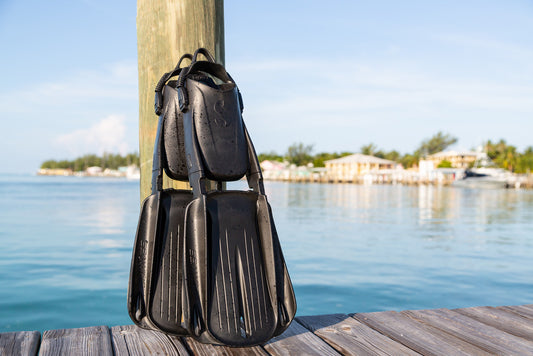
It's probably because no-one showed you how to use your fins properly, but don't worry, your scuba instructor will take care of that.
A pair of fins fitted to your feet can give you the opportunity to use the most powerful muscles in your body. That's your thigh muscles. If you have been making bicycling movements in the water, it certainly stirs things up a bit but it doesn't result in very much forward progress. You need to be sure to present the blade of each fin at the best angle to the water, in order to shift as much as you can.
Try this in the pool, with fins fitted. Face a wall. Stretch out your arms so that your hands or fingertips touch the pool wall. Point your feet and stretch your legs out rather like a ballet dancer. Now lift a straightened leg and kick downwards followed by the other and then the other. Keep going. Can you feel the force that you are exerting on your hands? Keep those legs straight. Keep kicking.
It's the forward kick that has the most effect. It's rather like using the last part of a footballer's kick when he takes a penalty shot. It doesn't matter that you bend your knee a little on the backward stroke. Kick, kick, kick!
You'll find that you can take long leisurely fin-strokes and enjoy a lot of result. You don't have to flutter kick very fast unless you are using a special pair of fins designed for you to do that. Thos long leisurely fin-strokes are such that you can keep them up for a long time and cover a lot of distance.
Should you find that you turn a corner of the reef and encounter a fierce current, you will have plenty of energy in reserve to fin quickly and accelerate through it to where the water is calm again.
Being efficient with your fins, using the most powerful muscles you've got, results in an efficiency of effort that translates into less air used.
Are you still doing a kind of breaststroke with your hands. The hands of scuba divers are used for grasping and holding things. Put them down by your side or fold them across your chest. Those sudden arm-sweeping movements can be a nuisance and catch in the regulator hose of another diver, ripping his mouthpiece out of his mouth. Once you've got your finning action sorted, it's time to look at the rest of your kit. Get as streamlined as you can. A diver swims horizontally in the direction he wants to go. If you are tending to walk upright through the water, you'll need to check your buoyancy control.



